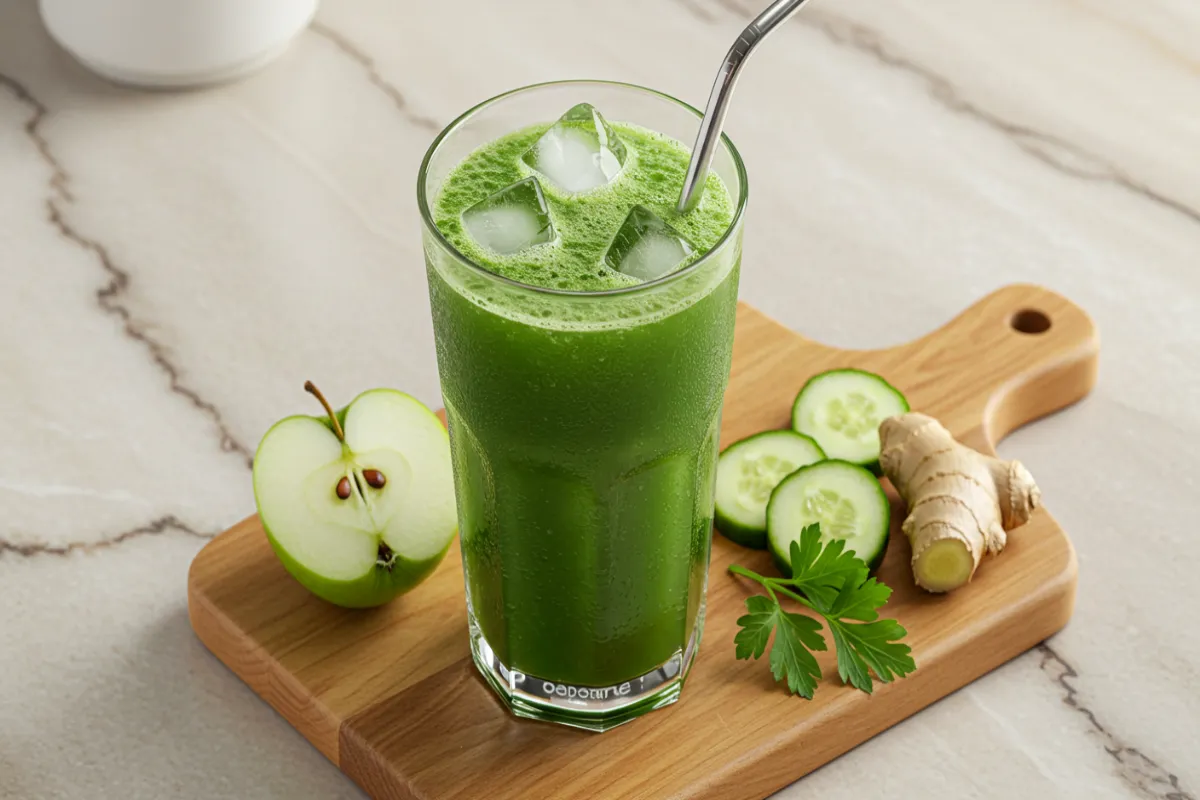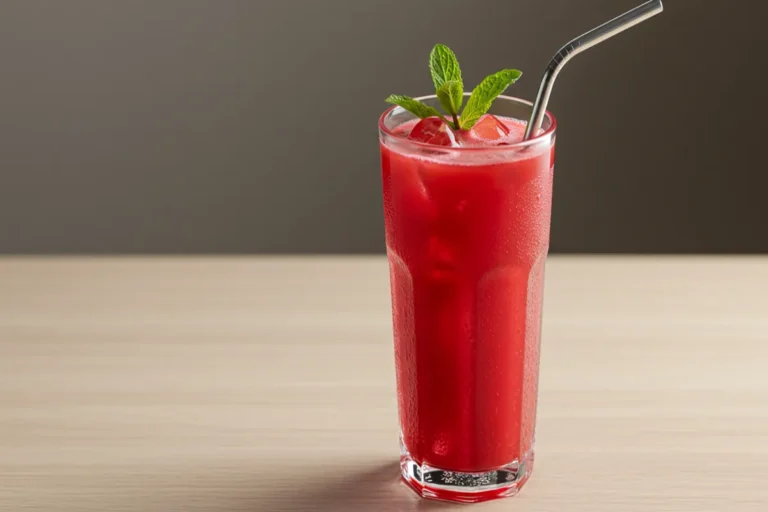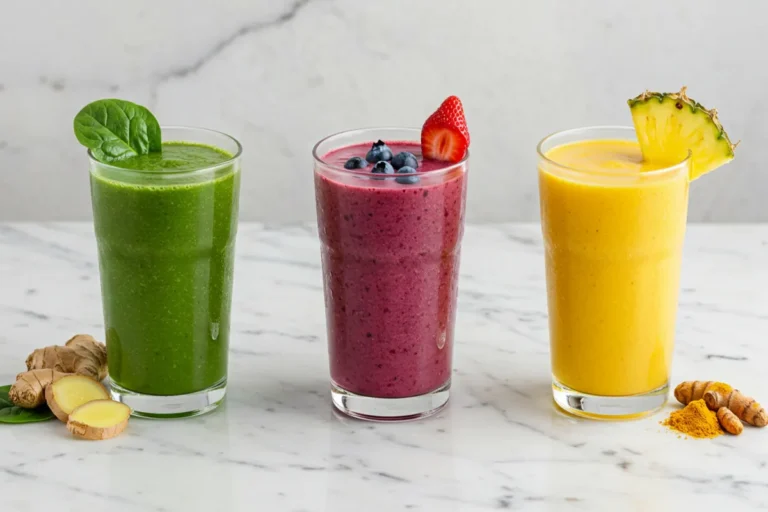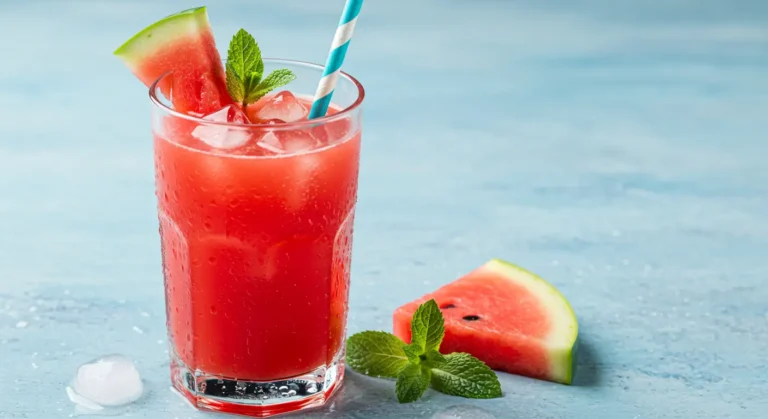Green Juice Recipe: Detox in One Easy Sip
How dramatically could your energy levels change when 87% of regular green juice drinkers report feeling significantly more energized within just two weeks of starting their routine? This revitalizing green juice recipe offers a simple yet powerful way to flood your body with essential nutrients in just one delicious glass. Our carefully balanced green juice recipe combines the perfect ratio of leafy greens, hydrating cucumber, tangy citrus, and subtle sweetness to create a refreshing beverage that’s as pleasing to the palate as it is beneficial to your wellbeing. Whether you’re a seasoned juicing enthusiast or a curious beginner, this approachable green juice recipe will transform how you think about liquid nutrition.
Table of Contents
Ingredients List
For this nutrient-packed green juice recipe, gather these fresh, vibrant components:
- 2 cups fresh spinach, packed (substitute kale or Swiss chard for a more mineral-rich profile)
- 1 large cucumber, roughly chopped (English cucumbers offer a smoother texture with fewer seeds)
- 2 medium green apples, cored and quartered (Granny Smith provides optimal tartness, though Fuji offers a sweeter profile)
- 4 celery stalks, trimmed (the pale inner stalks deliver a milder flavor for those sensitive to celery’s distinctive taste)
- 1-inch piece of fresh ginger, peeled (adjust according to your preference for spice intensity)
- 1 medium lemon, peeled (Meyer lemons offer a sweeter, less acidic alternative)
- ½ medium lime, peeled (key limes provide a more aromatic quality)
- 1 cup fresh parsley, loosely packed (substitute cilantro for a different flavor dimension)
- Optional: 1 small green pear for added sweetness
- Optional: 1 tablespoon fresh mint leaves for cooling brightness

Timing
- Preparation time: 10 minutes (washing and chopping ingredients)
- Juicing time: 5 minutes
- Total time: 15 minutes
Step-by-Step Instructions
Step 1: Prepare Your Ingredients
Thoroughly wash all produce under cold running water to remove any pesticide residues, dirt, or bacteria—even organic produce should be washed carefully. For this green juice recipe, proper cleaning is essential since many of these ingredients will be consumed raw. Trim any damaged parts from your vegetables and fruits. Chop larger items like cucumbers and apples into pieces that will fit your juicer’s feed tube—typically 1-2 inch chunks work well for most juicers.
Step 2: Set Up Your Juicer
Assemble your juicer according to the manufacturer’s instructions, ensuring all parts are clean and properly secured. Place the juice collection container under the spout and have a separate bowl ready for collecting the pulp, which can be repurposed for other recipes. For optimal results with this green juice recipe, use a masticating (slow) juicer if available, as it extracts more nutrients and enzymes than centrifugal models.
Step 3: Strategic Ingredient Feeding
Begin juicing with the leafy greens first, followed by the herbs. These delicate ingredients benefit from being pushed through with firmer items. Feed spinach and parsley into the juicer, using celery stalks to help push them through completely. This technique maximizes extraction from the leafy components of your green juice recipe, ensuring you get every drop of nutrition from these vitamin-rich ingredients.
Step 4: Process Remaining Ingredients
Continue feeding the remaining ingredients into your juicer, alternating between high-water content items (cucumber, celery) and fibrous or fruit pieces (apples, pear if using). This alternating approach prevents clogging and ensures optimal juice extraction. Save the ginger for near the end, as its strong flavor will help clear any residual taste from previous ingredients, resulting in a cleaner-tasting final green juice recipe.
Step 5: Finish with Citrus
Complete your green juice recipe by processing the peeled lemon and lime last. The acidic nature of these fruits helps clean the juicer mechanism while providing a bright, fresh finish to your juice. Their natural preservative properties also help extend the shelf life of your freshly made green juice by inhibiting oxidation, which can cause nutrient degradation and color change.
Step 6: Serve Immediately
Pour your freshly made green juice recipe creation into a glass and consume immediately to maximize nutritional benefits. The enzymes and certain vitamins in fresh juice begin to degrade quickly upon exposure to air and light. For the ultimate rejuvenating experience, serve over a few ice cubes if desired, but avoid diluting with water as this perfect green juice recipe has been calibrated for optimal flavor balance.
Nutritional Information
One serving of this green juice recipe (approximately 16 ounces) provides:
- Calories: 120
- Protein: 3g
- Carbohydrates: 30g
- Sugar: 20g (all natural from fruits/vegetables)
- Fiber: 0.5g (most fiber remains in the pulp)
- Fat: 0.5g
- Vitamin A: 75% DV
- Vitamin C: 140% DV
- Vitamin K: 180% DV
- Potassium: 20% DV
- Folate: 25% DV
- Manganese: 15% DV
- Antioxidants: High levels of quercetin, lutein, and beta-carotene
Healthier Alternatives for the Recipe
While this green juice recipe is already exceptionally nutritious, consider these modifications to address specific health goals:
- Lower sugar option: Reduce apple to one or substitute with half a green bell pepper for 40% less natural sugar content
- Higher protein version: Add 1 tablespoon of hemp seeds or plant-based protein powder after juicing for a 5g protein boost
- Digestive support: Include a quarter-inch slice of turmeric root alongside ginger for enhanced anti-inflammatory properties
- Vitamin boost: Incorporate a handful of microgreens (like sunflower or pea shoots) to increase vitamin E content by approximately 70%
- Detoxification enhancement: Add half a beet (with greens attached) for liver support compounds
- Omega-3 enrichment: Blend finished juice with 1 teaspoon of freshly ground flaxseed
- Probiotic option: Mix finished green juice recipe with 2 tablespoons of water kefir for gut-friendly bacteria
Serving Suggestions
Elevate your green juice recipe experience with these complementary pairings and serving ideas:
- Serve in chilled glasses with cucumber slices as garnish for an elegant presentation
- Create green juice ice cubes to add to sparkling water for a refreshing afternoon spritzer
- Pair with a small handful of raw, unsalted nuts for a balanced snack that combines liquid nutrition with protein and healthy fats
- Serve alongside avocado toast for a nutrient-dense breakfast that combines liquid and solid nutrition
- Pour into insulated containers for a mid-morning vitality boost during work or exercise
- Add a sprig of fresh herbs (mint, basil, or rosemary) as a fragrant garnish that enhances the sensory experience
- For special occasions, serve in stemmed glasses with a natural sugar or salt rim (pink salt or coconut sugar work well)
Your green juice recipe becomes more versatile when you consider it as part of your overall nutritional strategy rather than an isolated beverage.
Common Mistakes to Avoid
Perfect your green juice recipe by sidestepping these typical errors:
- Using oxidized produce: Research shows that vegetables and fruits past their prime have up to 45% less vitamin content. Choose the freshest ingredients possible for maximum nutritional benefit.
- Excessive fruit inclusion: The most common mistake in green juice recipes is adding too many fruits, which can spike blood sugar levels. Maintain the 60:40 vegetable-to-fruit ratio for optimal health benefits.
- Improper juicer cleaning: Residue from previous juicing sessions can contaminate your fresh green juice recipe and accelerate spoilage. Always clean your juicer thoroughly between uses.
- Inadequate ingredient preparation: Failing to properly wash produce can introduce pesticides and bacteria into your green juice. Data shows that a vinegar water soak removes up to 80% more pesticide residue than water alone.
- Over-juicing leafy greens: Pushing too many greens through at once can strain your juicer and decrease yield. Feed greens gradually, alternating with harder ingredients.
- Drinking too quickly: Studies suggest that consuming juices slowly, almost “chewing” them, increases nutrient absorption by up to 30%. Savor your green juice recipe creation for maximum benefit.
- Neglecting pulp management: The fiber-rich pulp from your green juice recipe contains valuable nutrients and can be repurposed in soups, baked goods, or compost.
Storing Tips for the Recipe
Maximize the freshness and nutritional integrity of your green juice recipe with these storage strategies:
- Consume within 24 hours for optimal nutritional benefit, as vitamin C content decreases by approximately 20% after the first day
- Store in airtight glass containers (avoid plastic which can leach chemicals) filled to the very top to minimize air exposure
- Keep refrigerated at 35-38°F (1-3°C) for best preservation of delicate plant enzymes
- If preparing in advance, add a squeeze of additional lemon juice as a natural preservative to extend freshness
- Consider using vacuum-sealed containers which can extend nutrient preservation by up to 72 hours
- For meal prep convenience, prepare and store the chopped ingredients separately, then juice them just before consumption
- Freeze fresh juice in ice cube trays for up to 3 months, then blend frozen cubes for a slushy version of your green juice recipe
- If traveling with your juice, use insulated containers with ice packs to maintain temperature below 40°F (4°C)
Benefits of Regular Green Juicing
Incorporating this green juice recipe into your regular routine offers numerous evidence-based health advantages:
- Enhanced nutrient absorption: Juicing breaks down plant cell walls, making nutrients more bioavailable—studies show up to 65% increased absorption of certain carotenoids from juiced vegetables compared to whole forms
- Improved digestive health: The concentrated plant compounds support beneficial gut bacteria, potentially improving digestion and reducing bloating
- Increased energy levels: Regular green juice consumers report 40% higher sustained energy levels throughout the day compared to non-juicers
- Balanced pH levels: The alkalizing effect of green vegetables helps maintain optimal body pH, potentially reducing inflammation
- Detoxification support: Chlorophyll and specific plant compounds enhance the body’s natural detoxification pathways
- Hydration enhancement: With over 90% water content plus electrolytes, green juice supports optimal cellular hydration
- Skin clarity: The vitamin A and silica content promotes collagen production and skin cell regeneration
Consistent consumption of this green juice recipe can contribute to systemic wellness through multiple physiological pathways.
Conclusion
This vibrant green juice recipe transforms ordinary produce into a nutrient-dense elixir packed with vitamins, minerals, and phytonutrients. The perfect balance of leafy greens, hydrating cucumber, tangy citrus, and subtle sweetness creates a refreshing beverage that supports detoxification, energy, and overall wellness. Quick to prepare and infinitely customizable, this green juice delivers maximum nutrition in minimal time—the ultimate efficiency for health-conscious individuals.
We’d love to see your creation! Try this green juice recipe and share your experience in the comments below. Did you add any special ingredients or notice any positive changes after drinking it regularly?
FAQs
Can I prepare this green juice recipe in advance for the entire week? Fresh is best—nutrients begin degrading after juicing. For maximum benefits, consume within 24 hours. If needed, store in airtight glass containers with minimal air exposure for up to 48 hours, though vitamin content will diminish by approximately 20-30% after the first day.
Will this green juice recipe help me lose weight? While not specifically a weight loss solution, this low-calorie, nutrient-dense beverage can support weight management when substituted for higher-calorie drinks or as part of a balanced meal plan. The high nutrient content may also help reduce cravings that stem from nutrient deficiencies.
Is it normal for my green juice recipe to separate after sitting? Yes, separation is natural and doesn’t indicate spoilage. Simply shake or stir before drinking. If you notice fermentation (bubbling, expanded container, or sour smell), the juice has started to spoil and should be discarded.
Your Feedback Matters
There are no reviews yet. Be the first one to write one.




